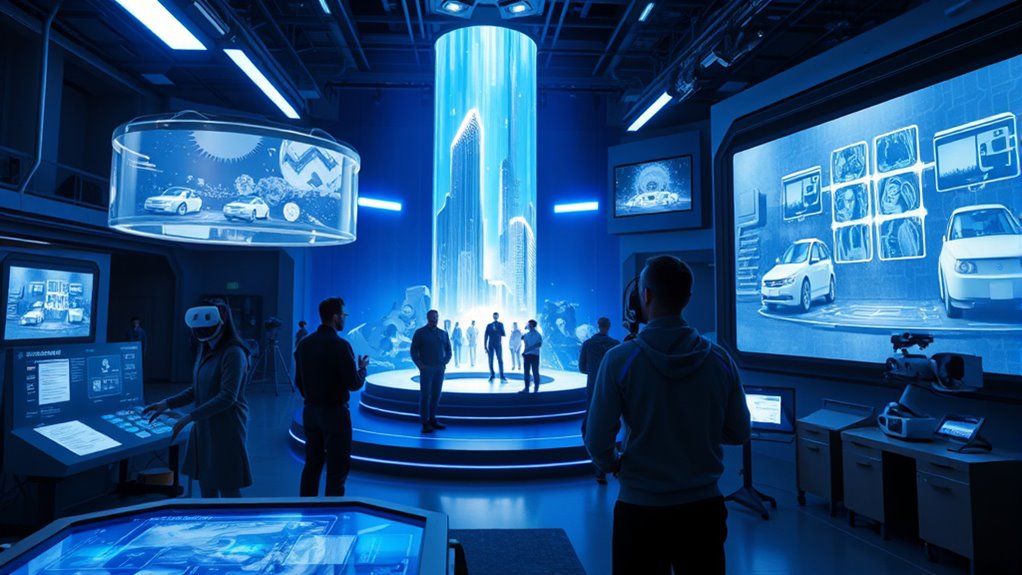Hollywood 2.0 is here, powered by AI transforming every stage of film production. AI tools help you develop scripts tailored to audience preferences, automate workflows, and create realistic virtual actors and effects faster and more cost-effectively. Immersive VR and AR technologies are reshaping how viewers engage with stories. As ethical and legal concerns grow, exploring these innovations reveals how AI is fundamentally changing filmmaking—if you keep exploring, you’ll discover the full scope of this revolution.
Key Takeaways
- AI-driven script analysis and market data optimize storytelling, reducing development time and aligning content with audience preferences.
- Virtual actors and deepfake technology enable realistic digital performances, reducing production costs and expanding creative possibilities.
- Automated post-production tools streamline visual effects, editing, and rendering, accelerating project workflows and enhancing visual quality.
- AI enhances decision-making and resource management during pre-production, improving planning accuracy and reducing risks.
- Immersive AR and VR technologies transform audience engagement, creating interactive experiences from script to screen.
The Rise of AI-Centric Film Studios and Market Dynamics

Since 2022, the number of AI-centric film studios has surged globally, with over 65 launched and more than 30 emerging in 2024 and early 2025. These studios are transforming the industry by integrating AI at every production stage, from scripting to post-production. You’ll notice that founders prioritize narrative quality as their main competitive edge, rather than just technical prowess. As AI tools become more widespread, studios are able to cut costs and streamline workflows, gaining a significant edge in a competitive market. The global AI in film market is projected to reach $14.1 billion by 2033, growing at a CAGR of 25.7%. This rapid expansion reflects how AI is reshaping content creation, enabling studios to produce higher-quality content faster and more efficiently. The integration of AI in creative processes is also opening new avenues for storytelling innovations and storytelling possibilities in filmmaking.
Transforming Pre-Production With Intelligent Tools

You can streamline your pre-production process by leveraging AI-driven script development tools that analyze audience preferences and generate tailored story ideas. Automated project planning software helps you organize timelines and resources more efficiently, reducing delays and costs. By integrating these intelligent tools, you gain a competitive edge through faster, data-backed decision-making from concept to planning. Additionally, understanding traditional butter making techniques can inspire innovative methods for crafting authentic, artisanal content in your projects.
AI-Driven Script Development
AI-driven tools are revolutionizing script development by streamlining and enhancing the pre-production process. You can now generate story ideas, refine plot points, and craft dialogue faster using AI algorithms that analyze audience preferences and market trends. These tools suggest story arcs and scene structures based on data patterns, helping you tailor scripts to maximize commercial impact. Automation of routine tasks, like formatting and version control, frees you to focus on creative storytelling. Predictive models assist in selecting projects with high market potential, reducing the risk of costly missteps. Major studios leverage AI for rapid script iteration, enabling faster development cycles. Additionally, integrating insights from content analysis can further refine storytelling techniques to resonate with target audiences. Implementing predictive modeling also allows creators to anticipate audience reactions and adapt narratives accordingly, increasing the likelihood of success. Employing market trend analysis helps identify emerging genres and themes, giving your projects a competitive edge. Overall, AI-powered script development accelerates creativity, optimizes content for audiences, and enhances your ability to produce compelling, market-ready stories.
Market-Backed Story Ideas
Market-backed story ideas are revolutionizing pre-production by providing filmmakers with data-driven insights that align narratives with audience demand. You can now leverage AI tools that analyze vast amounts of market data, social media trends, and viewer preferences to identify what genres, themes, and story elements resonate most. This real-time intelligence helps you develop concepts with higher commercial potential, reducing the risk of flop projects. AI-driven platforms suggest story arcs, character types, and plot twists that are statistically proven to engage audiences. By integrating these insights early, you streamline idea generation and focus on crafting stories that have a proven appeal. Additionally, understanding retirement planning in various states can inspire stories about financial security and aging, tapping into current social themes. Incorporating audience engagement metrics can further refine story development to ensure maximum resonance and success. This approach ensures your project is both creatively compelling and market-ready from the outset. Moreover, leveraging financial literacy can add depth to characters and storylines centered around economic challenges and personal growth, making narratives even more relatable. Using market analytics also enables filmmakers to adapt scripts dynamically as trends evolve, ensuring relevance in a competitive landscape.
Automated Project Planning
Automated project planning is revolutionizing pre-production by integrating intelligent tools that streamline scheduling, resource allocation, and workflow management. You can now create detailed production timelines that automatically adjust as your project evolves, saving time and reducing errors. AI-driven algorithms analyze countless data points to optimize resource distribution, ensuring the right talent, equipment, and locations are available when needed. These tools identify potential bottlenecks early, allowing you to proactively address issues before they impact the schedule. With real-time updates, you stay informed about project progress, making collaboration smoother across departments. This integration accelerates decision-making, cuts down on manual planning efforts, and enhances overall efficiency. As a result, you gain better control over your project, reducing costs and increasing the likelihood of a successful production.
Revolutionizing Scriptwriting and Narrative Development

How is AI transforming scriptwriting and narrative development in filmmaking? You now have access to tools that analyze vast audience data, helping you craft stories tailored to viewer preferences. AI suggests compelling story arcs, dialogue, and scene structures based on data patterns, speeding up the creative process. It automates routine tasks like script formatting and versioning, freeing you to focus on innovation. Predictive models assess a project’s commercial potential, guiding your choices early on. Major studios use AI for rapid script iterations, reducing development time and costs. By integrating AI, you can refine narratives based on audience insights, ensuring your stories resonate with audiences and maximize engagement—making storytelling more efficient, data-driven, and audience-centric. Additionally, understanding supermarket hours can be beneficial for timing your research and resource gathering when planning projects or sourcing materials. Leveraging film industry automation tools can further streamline production workflows and enhance creative collaboration. Implementing storytelling analytics can also help identify audience preferences, allowing for more targeted and impactful narratives. Embracing AI-driven content clusters allows filmmakers to develop interconnected storylines that deepen audience engagement and increase overall content relevance.
Virtual Actors and Deepfake Innovations in Casting

Virtual actors and deepfake technology are transforming casting by creating realistic performances without physical presence, but ethical concerns about authenticity and transparency remain. You need to consider how these innovations impact traditional casting practices and actor rights. As visual effects improve, balancing innovation with ethical standards becomes essential. Additionally, understanding creative practice such as popular choices for various breeds, can provide insight into cultural and aesthetic considerations that parallel the evolving landscape of digital casting. Recognizing industry regulations is also crucial to ensure responsible use of these technologies in entertainment. With advancements in digital manipulation, the ability to craft convincing performances continues to grow, but it also raises questions about authenticity and consent. Proper privacy safeguards are necessary to protect the rights of actors and ensure transparent use of these powerful tools.
Ethical Casting Practices
As AI technologies like deepfakes and virtual actors become more prevalent in casting, ethical considerations have taken center stage. You face questions about authenticity, consent, and transparency. To navigate these issues, consider:
- Ensuring actors or their estates give explicit permission for AI recreations.
- Clearly disclosing when virtual actors or deepfakes are used to viewers.
- Respecting intellectual property rights of original performances.
- Avoiding misrepresentation that could deceive or harm audiences or performers.
- Developing ethical guidelines to govern the use of AI in casting and production processes.
- Recognizing the importance of regulatory compliance to ensure legal and ethical standards are met.
- Staying informed about industry standards that are emerging to address AI utilization in entertainment.
- Incorporating financial management principles like transparent budgeting to ensure responsible AI integration and avoid overspending in new technology adoption.
- Promoting ongoing ethical training for filmmakers and casting professionals to foster responsible use of AI tools.
Balancing innovation with ethical responsibility is essential. You must protect actors’ rights while embracing new storytelling tools. Transparent practices build trust and prevent exploitation. As these technologies evolve, establishing industry standards will be critical to maintaining integrity in casting.
Visual Effects Advancements
Advancements in visual effects, particularly through virtual actors and deepfake technology, are transforming the casting process in filmmaking. You can now create realistic digital versions of actors, enabling performances without physical presence or risking aging and health issues. Deepfakes allow seamless de-aging, rejuvenation, or the portrayal of historical figures, expanding creative possibilities. These tools reduce reliance on traditional VFX, cutting post-production time and costs. You might use AI-generated characters to perform stunts or scenes impossible in real life, opening new narrative avenues. However, ethical considerations around authenticity and transparency remain. Overall, virtual actors and deepfake innovations give you more control over casting, enabling the realization of visions previously limited by physical, financial, or logistical constraints.
Enhancing Visual Effects and Post-Production Efficiency

AI is revolutionizing visual effects and post-production by streamlining workflows and reducing time and costs. You can now leverage AI-powered tools to automate complex tasks, such as rotoscoping, compositing, and color grading, speeding up the entire process. These tools enhance precision, minimizing manual effort and errors. With AI, you’ll benefit from:
- Faster rendering and processing times
- Real-time visual effects previews
- Automated scene cleanup and object removal
- Improved consistency across shots and scenes
This technology allows you to focus on creative refinement rather than technical bottlenecks. As a result, post-production becomes more cost-effective and agile, enabling quicker delivery without sacrificing quality. Embracing AI in this phase guarantees your projects stay competitive in a rapidly evolving industry.
AI-Driven Audience Analytics and Market Prediction

How can studios accurately predict a film’s market performance before production begins? AI-driven audience analytics analyze vast amounts of data, including social media trends, viewer preferences, and historical box office results. By identifying patterns and sentiment, AI models forecast potential audience reception and commercial success with remarkable accuracy. You benefit from these insights by making informed decisions on project viability, target demographics, and marketing strategies early in development. AI tools also simulate release scenarios, helping you optimize timing and distribution channels. This predictive capability reduces financial risk, guides content creation, and enables personalized marketing campaigns. Ultimately, AI-driven market prediction empowers you to select projects with higher potential returns, ensuring your investments align with audience demand and market trends before a single frame is shot.
Immersive Technologies: VR and AR Changing Viewing Experiences

You’re now exploring how VR storytelling transports you directly into the narrative, making you feel like part of the scene. AR marketing transforms traditional ads into interactive experiences that engage viewers on a deeper level. These immersive technologies are revolutionizing how audiences connect with films and promotional content, creating new opportunities for engagement.
Virtual Reality Storytelling
Have you ever wondered how virtual reality is transforming the way stories are told on screen? VR puts you right inside the story, offering immersive experiences that traditional media can’t match. You can explore detailed worlds, interact with characters, and influence the narrative’s flow. This technology creates a sense of presence and emotional connection like never before.
With VR storytelling, you’ll experience:
- Fully immersive environments that transport you to new worlds
- Interactive narratives allowing real-time choices
- Enhanced emotional engagement through sensory immersion
- New storytelling formats blending gaming, film, and education
Augmented Reality Marketing
Augmented reality (AR) is revolutionizing movie marketing by creating interactive and immersive experiences that captivate audiences. You can now engage with movie posters that come alive with 3D characters or hidden clues, transforming static ads into dynamic storytelling tools. AR enables fans to virtually try on costumes, explore sets, or preview scenes, deepening their connection to the film. These experiences boost excitement and anticipation, encouraging sharing across social media. Studios leverage AR to deliver personalized content, making marketing campaigns more targeted and effective. As AR becomes more integrated into campaigns, your engagement shifts from passive viewing to active participation, making marketing memorable and immersive. This evolution helps studios stand out in a crowded media landscape, driving higher interest and stronger audience loyalty.
Ethical Considerations and Challenges of AI in Cinema

As AI becomes increasingly integrated into cinema, ethical concerns surrounding its use grow more urgent. You need to contemplate issues like authenticity, transparency, and consent.
- Virtual actors and deepfakes raise questions about consent and the misuse of likenesses without permission.
- AI’s ability to generate realistic content can blur the line between reality and fiction, risking misinformation.
- Biases in training data may lead to biased portrayals, reinforcing stereotypes or marginalizing groups.
- The displacement of human workers in areas like visual effects and editing creates ethical debates on employment and fair labor practices.
Balancing technological innovation with responsibility is vital. You must navigate these challenges to ensure AI benefits creators, audiences, and society without compromising integrity or ethics.
The Future of Filmmaking: Opportunities and Trends

The future of filmmaking is set to be transformed by emerging AI-driven opportunities and trends that expand creative possibilities and streamline production processes. You’ll see more studios leveraging AI for script development, scene planning, and visual effects, making content creation faster and more innovative. Virtual actors and deepfake technology will become commonplace, allowing for more flexible casting and cost-effective de-aging. Immersive experiences like VR and AR will redefine storytelling, engaging audiences in new ways. Predictive analytics will help you identify high-potential projects early, reducing risk and boosting ROI. Automation throughout production will cut costs and time, freeing you to focus on storytelling. Overall, AI’s integration promises a more dynamic, efficient, and personalized future in filmmaking.
How AI Is Reshaping Distribution and Audience Engagement

Have you noticed how AI is transforming the way films reach audiences and keep them engaged? AI-driven tools personalize content recommendations, making streaming platforms more addictive. They analyze viewer data to suggest movies and shows tailored to your preferences. AI also enhances distribution by predicting regional demand, optimizing release schedules, and targeting specific demographics. Additionally, immersive technologies like VR and AR create interactive viewing experiences, drawing you deeper into stories. Here’s how AI reshapes distribution and engagement:
- Personalizes content suggestions based on your viewing habits
- Optimizes release timing for maximum audience reach
- Uses VR and AR for interactive, immersive experiences
- Provides targeted marketing campaigns to enhance viewer connection
Frequently Asked Questions
How Does AI Impact Traditional Filmmaking Roles and Employment?
AI transforms traditional filmmaking roles by automating routine tasks, freeing you to focus on creativity and storytelling. It reduces labor in areas like editing, visual effects, and post-production, which can lead to job displacement but also creates new opportunities in AI management and virtual actor creation. You need to adapt by developing skills in AI tools to stay relevant, as the industry shifts toward more tech-driven workflows.
What Are the Legal Implications of Using Deepfake Technology in Films?
Ever wonder about the legal minefield deepfake tech creates? Using deepfakes in films raises serious issues like rights and consent, especially when recreating actors without permission. You could face lawsuits or copyright claims if you don’t navigate intellectual property laws carefully. It’s vital to establish clear agreements, transparency, and ethical standards to avoid legal trouble. Are you prepared to handle the legal risks that come with this powerful technology?
How Do Studios Ensure Ai-Generated Content Maintains Artistic Integrity?
You guarantee AI-generated content maintains artistic integrity by setting clear creative guidelines and collaborating closely with human creators. You verify that AI tools enhance, rather than replace, artistic vision, and regularly review outputs for authenticity. You also involve diverse perspectives to safeguard originality and emotional depth. By balancing AI efficiency with human oversight, you preserve the storytelling quality, ensuring the final work stays true to its artistic intent.
Can AI Accurately Replicate Diverse Storytelling Styles Across Genres?
Yes, AI can accurately replicate diverse storytelling styles across genres by analyzing vast amounts of genre-specific data, including scripts, dialogue, and narrative structures. You can leverage AI to mimic unique tones, pacing, and cultural nuances, ensuring authenticity. With continuous learning and fine-tuning, AI tools adapt to different styles, helping you craft stories that resonate across genres while maintaining creative integrity and appealing to varied audiences.
What Are Consumers’ Privacy Concerns With Ai-Driven Audience Data Collection?
You’re concerned about your privacy when AI collects audience data, and rightly so. You worry about your personal information being misused or exposed, about targeted advertising invading your space, and about how your viewing habits are tracked without clear consent. You want transparency, control over your data, and assurances that your information isn’t used maliciously. Your privacy matters, and you expect companies to respect your boundaries while delivering personalized experiences.
Conclusion
As AI transforms every stage of filmmaking, you can’t ignore its growing influence—over 70% of studios now use AI tools to streamline production. This shift means more innovative stories and immersive experiences for audiences worldwide. Embrace the future, where technology release endless creative possibilities. The question isn’t if AI will change cinema, but how you’ll adapt to shape this exciting new era of storytelling.










